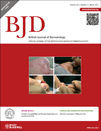A preliminary randomized controlled study to determine the application frequency of a new lymphoedema bandaging system
Funding sources Funding was provided by 3M.
Conflicts of interest C.J.M. and P.J.F. have both received research income on behalf of the Centre for Research & Implementation of Clinical Practice from 3M prior to and during this study.
The study was registered under clinicaltrials.gov no. NCT01096589.
Summary
Background Bandaging plays an important role in the treatment of lymphoedema.
Objective To investigate efficacy and safety of the 3M™ Coban™ 2 compression system (Coban 2 system) with different application frequencies in comparison to short-stretch bandaging.
Methods A multicentre, randomized, prospective study was performed with 82 patients suffering from arm or leg lymphoedema stage II or late stage II. Patients were allocated to traditional short-stretch bandaging five times per week or to the Coban 2 system applied two, three or five times per week for 19 days. Limb volume and adverse events were recorded at each study visit. The primary endpoint was percentage volume reduction.
Results The highest lymphoedema volume reduction was achieved with the Coban 2 system applied two times per week. A mean reduction of 18·7% (SD 14·5) in legs and 10·5% (SD 8·3) in arms was achieved. More frequent bandage changes of three and five times per week did not demonstrate additional benefits. Short-stretch bandaging five times per week showed a mean volume reduction of 10·9% (SD 5·2) and 8·2% (SD 3·1) for legs and arms, respectively. Bandage slippage was low for all treatment groups. A relevant change in overall mobility was achieved during the use of the Coban 2 system. The adverse reactions were in agreement with already known side-effects and did not differ remarkably between the treatment groups.
Conclusion The 3M™ Coban™ 2 compression system applied twice weekly demonstrated a high rate of volume reduction and a good safety profile. Oedema reduction was still effective with 4 days between bandage change, which allows a constant therapeutic effect in routine practice. This should give the patient a high degree of independence and mobility.




